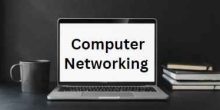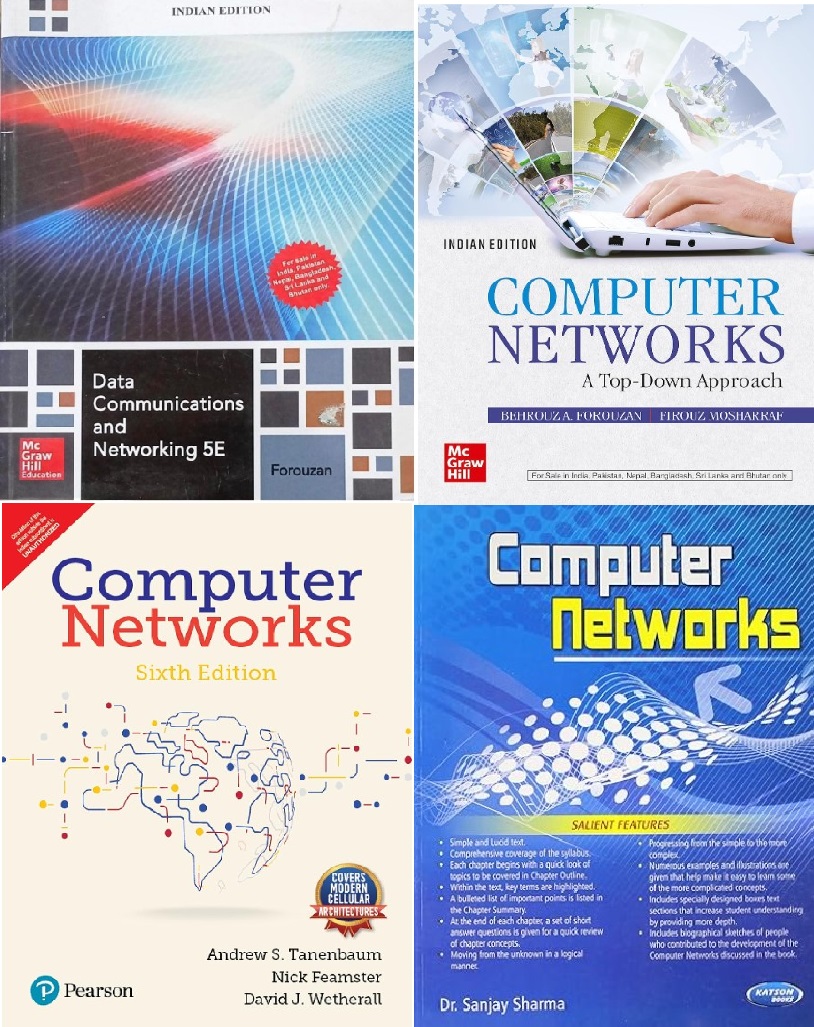Unit 1
Introduction to Data Communication Definition: Effectiveness, Basic Communication Components. Network Architecture Definition, History, Criteria, Goals and Applications of Networks, Categories of networks, Organization of the Internet, ISP, Protocols and standards, The OSI reference model, TCP/IP protocol suite, Network devices and components. Network topology design, Types of connections.
Q1 – What is internet?
Global system of interconnected computer networks
A collection of unrelated computers
Interconnection of networks
A single network
Ans – (3)
Explanation – The word “internet” with a lowercase “i” refers to a network of computers and devices connected together. It’s like a big web (hence the name “internet”) where information can be shared between different computers and devices. People use the internet for things like sending emails, watching videos, and searching for information.
Q2 – What is Internet?
Global system of interconnected computer networks
A collection of unrelated computers
Interconnection of networks
A single network
Ans – (1)
Explanation – “Internet” with a capital “I” specifically refers to the global system of interconnected computer networks that use the Internet Protocol Suite (TCP/IP) to link devices worldwide. Essentially, it’s the big worldwide network that connects millions of smaller networks together.
Q3 – What is a computer network?
A device used to display information on a computer screen
A collection of interconnected computers and devices that can communicate and share resources
A type of software used to create documents and presentations
The physical casing that protects a computer’s internal components
Ans – (2)
Explanation – A computer network is a collection of computers and devices that work together to exchange information, resources, and services. This interconnection enables the network’s electronic devices to communicate, share data, and work together.
Q4 – What is a Network Interface Card (NIC)?
A device that allows a computer to communicate with another device.
A central device that divides a network connection among several devices.
A networking device that connects all of the devices on the network to transport data to another device.
A device that manages the network security and prevents unauthorized access.
Ans – (1)
Explanation – A device that allows a computer to communicate with another device.
Q5 – How many types of cables are there?
5
4
3
2
Ans – (3)
Explanation –
- Twisted pair cables
- Coaxial cable
- Fibre optic cable
Q6 – What is the full form of OSI?
optical service implementation
open service Internet
open system interconnection
operating system interface
Ans – (3)
Explanation – The full form of OSI is “Open Systems Interconnection.” It’s a conceptual framework that standardizes the functions of a telecommunication or computing system into seven distinct layers. These layers help in understanding how different parts of a network interact with each other.
Q7 – How many layers are there in the ISO OSI reference model?
7
5
4
6
Ans – (1)
Explanation –
The ISO OSI reference model has seven layers: application, presentation, session, transport, network, data connection, and physical layer.
The acronym ISO stands for International Organization for Standardization.
The acronym OSI stands for Open Systems Interconnection.
Q8 – What are nodes in a computer network?
The computer that routes the data
The computer that terminates the data
The computer that originates the data
All of the mentioned
Ans – (4)
Explanation – In a computer network, nodes refer to devices that are connected to the network and can send, receive, or forward data. These devices can include computers, servers, routers, switches, printers, and more.
Q9 – Which type of topology is best suited for large businesses which must carefully control and coordinate the operation of distributed branch outlets?
Ring
Mesh
Hierarchical
Star
Ans – (4)
Explanation – In a star topology, each branch outlet is connected directly to a central hub, such as a switch or a router. This central hub can manage and control the communication flow between all the branch outlets. It offers centralized control and easier management, making it ideal for large businesses with distributed locations. Additionally, if one branch outlet fails, it typically does not affect the rest of the network, which enhances reliability.
Q10 – Which of the following transmission directions listed is not a legitimate channel?
Simplex
Half Duplex
Full Duplex
Double Duplex
Ans – (4)
Explanation –
“Double duplex” is not a standard term and might be confusing or misleading.
It’s best to stick to the established terms like half-duplex and full-duplex when discussing the duplex modes of communication in computer networks.
Q11 – What kind of transmission medium is most appropriate to carry data in a computer network that is exposed to electrical interferences?
Unshielded twisted pair
Optical fiber
Coaxial cable
Microwave
Ans – (2)
Explanation – Optical fiber is the most appropriate choice when dealing with electrical interferences. Optical fiber cables use light signals for data transmission, which are immune to electrical interference. Additionally, they offer high bandwidth and security benefits.
Q12 – Which one of the following is not a network topology?
Star
Ring
Bus
Peer to Peer
Ans – (4)
Explanation –
Peer to Peer is not a network topology; it’s a network architecture or a type of network where each node can act as both a client and a server, sharing resources directly with other nodes without the need for a central server
Q13 – Consider the following:
(1) Twisted pair cables
(2) Microwaves and Satellite Signals
(3) Repeaters
(4) Analog Transmissions
(5) Fiber optics
Which of the above is consider as a signal transmission medium is data communications?
(1) and (5)
(1) and (2)
(1) (2) and (5)
(1) (2) (3) and (5)
Ans – (3)
Explanation – In data communications,
Twisted pair cables – These are wires twisted together to reduce noise and interference. They are used in telephone lines and Ethernet networks to transmit data.
Microwaves and Satellite Signals – These use high-frequency radio waves to send data through the air. Microwaves are often used for long-distance communication, including satellite communication.
Repeaters – These are devices that receive and amplify a signal before sending it on. They extend the range of the transmission but are not a medium themselves.
Analog Transmissions – This refers to the method of transmitting signals but does not specify a medium.
Fiber optics – These are thin glass or plastic fibers that use light to transmit data over long distances with high speed and low loss.
So, the correct option is (1) (2) and (5)
Q14 – Which of the following cannot be used as a medium for 802.3 ethernet?
A thin coaxial cable
A twisted pair cable
A microwave link
A fiber optical cable
Ans – (3)
Explanation –
802.3 Ethernet, also known as Ethernet, typically utilizes physical media such as thin coaxial cables, twisted pair cables, and fiber optic cables for transmission.
However, microwave links are not commonly used as a medium for standard Ethernet networks. Microwave links are often used in wireless communication systems but are not part of the traditional wired Ethernet infrastructure.
Q15 – The term IANA stands for?
Internet Assigned Numbers Authority
Internal Assigned Numbers Authority
Internet Associative Numbers Authoritative
Internal Associative Numbers Authority
Ans – (1)
Explanation –
Internet Assigned Numbers Authority is responsible for the global coordination of the DNS Root, IP addressing, and other internet protocol resources. It allocates and maintains unique codes and numbering systems that are used in various internet protocols and standards.
Q16 – In specific, if the systems use separate protocols, which one of the following devices is used to link two systems?
Repeater
Gateway
Bridge
Hub
Ans – (2)
Explanation –
A gateway is a networking device that connects two separate networks that use different communication protocols. It translates data between the different protocols to enable communication between systems on the separate networks.
Q17 – A ____ is a central device that divides a network connection among several devices.
Switch
Hub
Router
Modem
Ans – (2)
Explanation – A Hub is a simple network device that connects multiple computers or other network devices together in a network.
Q18 – A ____ is a networking device that connects all of the devices on the network to transport data to another device.
Switch
Hub
Router
Modem
Ans – (1)
Explanation –
A Switch is a networking device that connects multiple devices within a network and efficiently manages the data traffic between them.
Q19 – Among Switch or Hub which is better?
Switch
Hub
Ans – (1)
A switch can transmit data directly to the intended device, while a hub broadcasts data to all devices connected to it, which can cause congestion and slow down the network.
Q20 – The correct order of corresponding OSI layers for having functionalities of routing and reconciling machine representation differences with shared access resolution and ASCII test protocol is?
Network, Physical, Transport, Data link
Network, Physical, Data link, Application
Network, Presentation, Data link, Application
Network, Presentation, Physical, Transport
Ans – (3)
Explanation –
Network layer – Routing occurs at this layer. It deals with logical addressing and routing of data packets between different networks.
Presentation layer – Reconciling machine representation differences happens at this layer. It is responsible for translating, encrypting, and formatting data for presentation to the application layer.
Data link layer – Shared access resolution occurs at this layer. It handles the transmission of data frames over the physical network medium and provides error detection and correction.
Application layer – ASCII text protocol is implemented at this layer. It provides network services directly to end-users or application processes.



